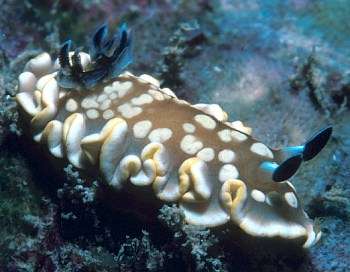
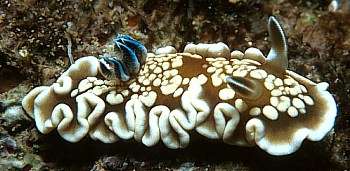
Glossodoris tomsmithi
Bertsch & Gosliner, 1989
Order: NUDIBRANCHIA
Suborder: DORIDINA
Superfamily: EUDORIDOIDEA
Family: Chromodorididae
DISTRIBUTION
Hawaii and Marshall Ids. [Also records on Forum from Okinawa, Guam and Wetsern Australia].
PHOTO
Specimens from Hawaii (UPPER) and Marshall Islands (LOWER). PHOTOS: Scott Johnson.
Note from Scott Johnson: "In the Hawaiian Islands, the species is relatively common ... while it is relatively rare in the Marshalls, where specimens tend to be larger with more numerous and more crowded dorsal white spots. Another interesting and consistent color variation is on the rhinophores: brown in the Marshalls and blue-black in Hawaii".
In Hawaiian specimens the yellow border seems to be more distinct. See Scott Johnson's message below for more photos showing colour variation.
See also Glossodoris sp. 6 from South Africa.
-
Bertsch, H. & Gosliner, T.M. (1989) Chromodorid nudibranchs from the Hawaiian Islands. The Veliger, 32(3): 247-265.
Rudman, W.B., 1999 (November 20) Glossodoris tomsmithi Bertsch & Gosliner, 1989. [In] Sea Slug Forum. Australian Museum, Sydney. Available from http://www.seaslugforum.net/find/glostoms
Related messages
Re: Glossodoris tomsmithi from Guam
May 7, 2007
From: Clay Carlson & Patty Jo Hoff
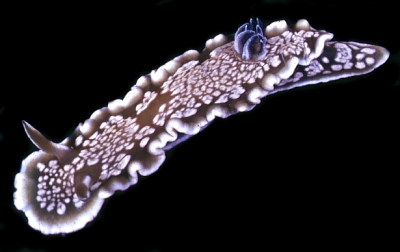
Concerning message #18446:
Bill,
Here is a sample of Glossodoris tomsmithi from Guam. We have only recorded 4 specimens -- the last in 1988. Bob Bolland also has it from Okinawa.
Locality: Cocos Reef, 8m, Guam, Pacific, 30 Sept. 1973. Length: 27mm. Photographer: C. Carlson & P.J. Hoff.
Clay Carlson
ccarlson@guam.net
Carlson, C. & Hoff, P.J., 2007 (May 7) Re: Glossodoris tomsmithi from Guam. [Message in] Sea Slug Forum. Australian Museum, Sydney. Available from http://www.seaslugforum.net/find/19874Dear Clay,
Thanks for another record - again from the tropical north-central Pacific. It would be nice to get a record somwhere between there and western Australia
Best wishes,
Bill Rudman
Re: Glossodoris tomsmithi from Ningaloo Reef, West
May 7, 2007
From: Rebecca Johnson
Concerning message #18446:
Hi Bill,
Welcome back!
I have been enjoying the Ceratosoma discussion and all of the chromodorids of late.
In checking our collection for data on Glossodoris tomsmithi, I saw that we have specimens from Okinawa, Maui, Oahu and the Marshall Islands.
See Bob Bolland's page: http://rfbolland.com/okislugs/glostoms.html
Also, it looks like Scott Johnson has usually seen brown rhinophores in the Marshall islands and the 'bluer' animals found in Hawaii usually have dark rhinophores. This animal from Ningaloo is bluish with brown rhinophores....It certainly is interesting.
Thanks and take care,
Rebecca
rjohnson@calacademy.org
Johnson, R.F., 2007 (May 7) Re: Glossodoris tomsmithi from Ningaloo Reef, West. [Message in] Sea Slug Forum. Australian Museum, Sydney. Available from http://www.seaslugforum.net/find/19866Dear Rebecca,
Yes it is an interesting find
Best wishes,
Bill Rudman
Glossodoris tomsmithi from Ningaloo Reef, Western Australia
May 1, 2007
From: Kristin Anderson
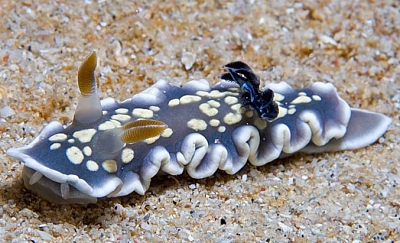
Dear Bill,
Came across this nudibranch for the first time in October 2006. The closest I can see is Glossodoris tomsmithi
Locality: Lighthouse Bay, Ningaloo Reef, 12m, Western Australia, Indian Ocean, 19 October 2006, limestone & hard coral reef. Length: 3 cms. Photographer: Kristin Anderson.
Kristin Anderson
kristin@oceansbyanderson.com
Anderson, K.J., 2007 (May 1) Glossodoris tomsmithi from Ningaloo Reef, Western Australia. [Message in] Sea Slug Forum. Australian Museum, Sydney. Available from http://www.seaslugforum.net/find/18446Dear Kristin,
I am pretty sure this is indeed G. tomsmithi - at least externally. The colour is identical to Hawaiian animals. It is indeed a strange find, as this species is only known at present from Hawaii and the Marshall Ids. If this is a natural distribution it's strange it hasn't been reported from other parts of the Pacific, before this find in the Indian Ocean.
Very interesting,
Bill Rudman
Are these Glossodoris tomsmithi eggs?
May 3, 2006
From: Mike Roberts
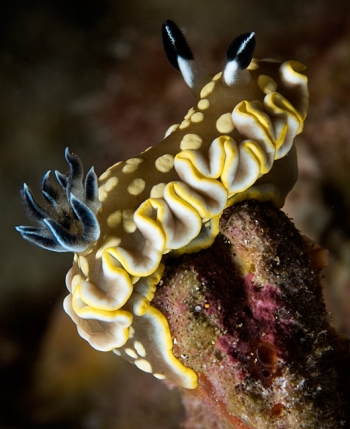
Hi
I found this specimen at about 25 fsw in the Makena area of South Maui April 24, 2006. I assume I have the slug ID right - Glossodoris tomsmithi - but these eggs were about 8 inches away. A match?
Locality: Makena area of South Maui, 25 feet, Hawaii, USA, Pacific, 24 April 2006, 50 vis lava/reef. Length: 1 inch. Photographer: Mike Roberts.
Thanks!
Mike
mike@tortuga-web.com
Roberts, M.B., 2006 (May 3) Are these Glossodoris tomsmithi eggs?. [Message in] Sea Slug Forum. Australian Museum, Sydney. Available from http://www.seaslugforum.net/find/16460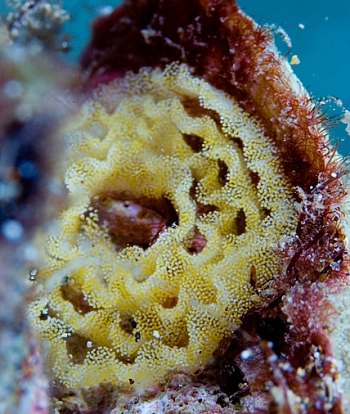
Dear Mike,
The slug is indeed G. tomsmithi. but I can't confirm the identity of the eggs. I can't recall a chromodorid laying such thin and 'frilly' egg ribbon such as this. I am afraid finding a nudibranch close to an egg mass is not good evidence of ownership. Some species do lay their eggs on their food, and so say nearby, but many don't and crawl away as soon as the ribbon is deposited.
Best wishes,
Bill Rudman
Re: Colour variation in Glossodoris tomsmithi
November 26, 1999
From: Scott Johnson
Hi Bill,
Regarding sizes of Glossodoris tomsmithi, in Hawaii it is typically 25mm or less in a more or less resting state. In the Marshalls, I have seen specimens approaching 40mm. In the photos sent earlier, all three of the Hawaiian specimens shown were in the 20-23mm range, while two from the Marshalls were about 35mm (sje178-1) and 25 to 30mm (sje178-5). Here in the Marshalls I see perhaps 2 or 3 individuals a year. In Hawaii, I could see them every dive if I went to the right places, and at Puako on the west coast of the island of Hawaii, I could see a dozen or more on a single dive. At Puako, a coral encrusted lava reef abruptly drops from 1-2m at the top to perhaps 8-10m at the bottom. The face of this drop is loaded with caves and overhangs, filled with sponges and corals such as Tubastraea. Glossodoris tomsmithi is (or at least was in 1980) quite common in these overhangs.
Scott.
johnson@kmr.ll.mit.edu
Johnson, S., 1999 (Nov 26) Re: Colour variation in Glossodoris tomsmithi. [Message in] Sea Slug Forum. Australian Museum, Sydney. Available from http://www.seaslugforum.net/find/1590Thanks Scott,
Bill Rudman.
Colour variation in Glossodoris tomsmithi
November 21, 1999
From: Scott Johnson
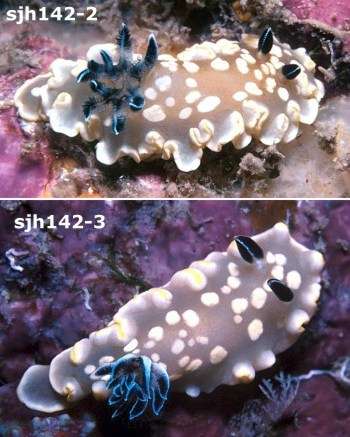

Hi Bill,
Attached are several shots of Glossodoris tomsmithi. H142 series are all from Hawaii, while the E178 ones are from the
Marshall Islands. In the Hawaiian Islands, the species is relatively common in many areas and is quite common on the Kona coast the the big island of Hawaii. It is relatively rare in the Marshalls, where specimens tend to be larger with more numerous and more crowded dorsal white spots than their Hawaiian relatives. Another interesting and consistent color variation is on the rhinophores: brown in the Marshalls and blue-black in Hawaii.
Scott
johnson@kmr.ll.mit.edu
Johnson, S., 1999 (Nov 21) Colour variation in Glossodoris tomsmithi. [Message in] Sea Slug Forum. Australian Museum, Sydney. Available from http://www.seaslugforum.net/find/1561Thanks Scott,
Can you give us some idea how big it grows? The only size indication I can find in the original description is your note on a Marshall Id animal being 22mm long, which matches Hawaiian specimens in your Hawaiian Nudibranchs.
Bill Rudman.
